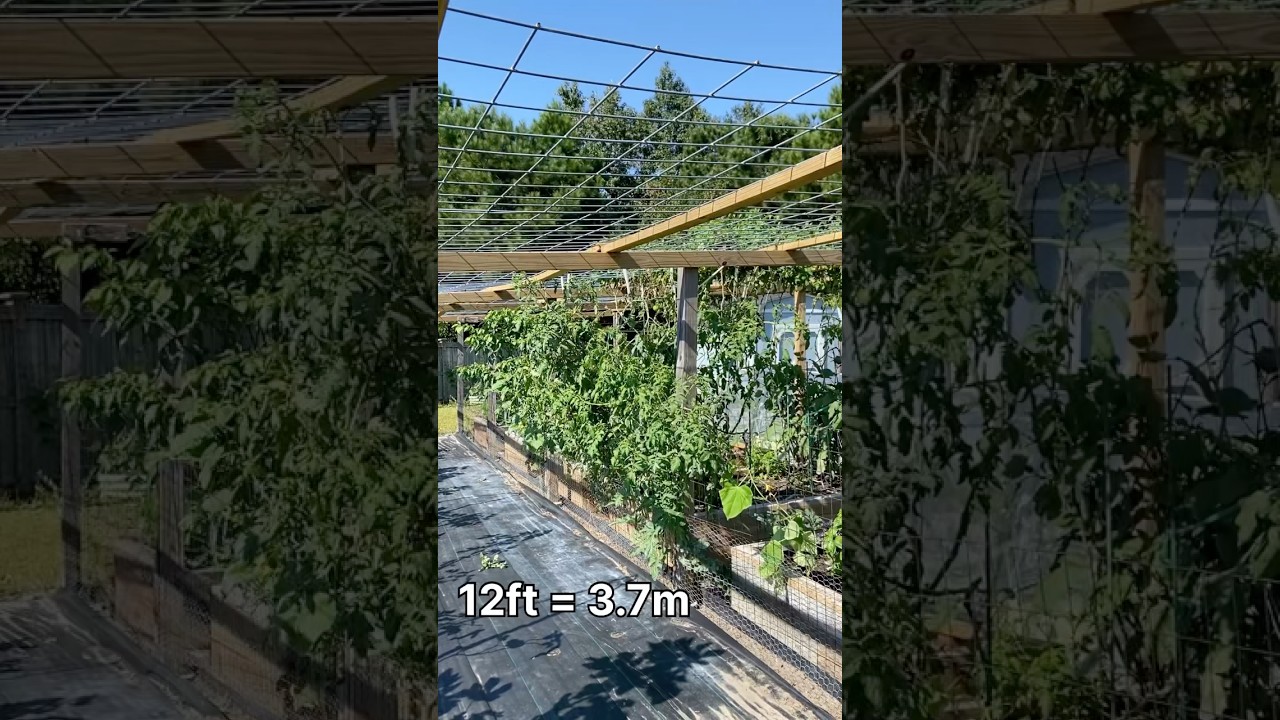Discover the secret to transforming your garden with 12-foot-tall tomato plants. Unlock the hidden key that can help you achieve extraordinary growth and bountiful harvests beyond your expectations. Get ready to nurture these towering tomatoes and take your gardening game to the next level.
The Hidden Key to Growing 12-Foot-Tall Tomato Plants
Introduction
There’s something effortlessly boastful about a tomato plant stretching skyward, its leaves unfurling like a green cathedral piercing through the mundane landscape of backyard gardens. If you’ve ever found yourself wistfully eyeing those vine monsters that seem to have a character all their own, you’re not alone. Growing a 12-foot-tall tomato plant isn’t just about tossing seeds into the soil and crossing your fingers; it’s about uncovering secrets that most gardeners overlook—the kind of secrets that could turn your patio into a verdant skyscraper of delicious fruit.
For years, I believed the magic of oversized tomatoes was mostly luck, a stroke of celestial timing or a fortuitous soil joke. But as I dug deeper—both literally and figuratively—I stumbled upon a horticultural whisper that changed everything. It turns out, the secret isn’t just watering well or basking your plants in sunlight; it’s about understanding the hidden key that unlocks their true potential. And no, it’s not some complicated fertilizer formula or an obscure watering technique. It’s something far more understated, yet incredibly powerful.
So, whether you’re a seasoned green thumb or a hopeful beginner eager to see your plants reach for the clouds, buckle up. We’re about to navigate the green labyrinth of tomato-growing—where the leap from modest pots to 12-foot triumphs hinges on one surprisingly simple principle. Prepare to be surprised, perhaps even a little amused, as we explore how to turn ordinary tomato plants into beanstalks of flavor.
The Science behind the Tallest Tomato Plants
Growing a tomato that rivals stories of Jack and his beanstalk isn’t a matter of wishful thinking; it’s rooted in science—growing, yes, but also in the subtle arts of plant biology and environment manipulation. At the core of it, the secret ingredient is the right combination of genetics, nutrition, and aromatically perfect conditions.
To truly reach such majestic heights, a tomato plant needs its fundamentals—sunshine, water, and rich, well-drained soil—plus a little extra. The key isn’t just giving your plant what it needs; it’s giving it what it craves. A whisper of nitrogen here, a dash of calcium there, and suddenly your plant is not just shrugging off the ordinary; it’s growling like a beast, reaching for the sky with all its green might. When paired with the perfect blend of light—think no-shade zones—and tender, consistent care, these plants transform from modest shrubs into sprawling vine giants.
But beyond these basics, there’s an unspoken truth: the influence of plant training and pruning. Allow me to clarify—this isn’t about some medieval form of botanical torture; it’s about guiding your tomato plant’s natural growth patterns toward the ultimate goal. Training those sprawling vines onto sturdy trellises, removing suckers that hinder height, and knowing when to intervene—these are the dance moves of a seasoned gardener. When mastered, your tomato plant’s internal genetics are motivated by your hands to aim for the stars, and—suddenly—the reach for 12 feet becomes less of a miracle and more of an inevitability.
The Surprising Role of Nutrition and Soil Management
Here’s where things get unexpectedly vital: soil isn’t just dirt, and nutrition isn’t just about fertilizing—well, in most cases, it’s about precisely what kinds of nutrients you introduce and how you treat your earth. The secret to towering tomatoes lies deep in the roots—literally—and that means going beyond typical watering routines to create a veritable feast for those hungry roots.
Choosing the right soil mix is like handpicking the perfect dish for your flourishing green giants. Loamy soil with a balanced blend of organic matter provides the immediate foundation, but the real game-changer is amending that soil with compost, worm castings, and even aged manure. These natural fertilizers act like rocket fuel—boosting plant growth, vitality, and, most importantly, the potential for expansive height. If you’ve ever watched a lush garden flourish after a good rain, you know that a healthy, nutrient-rich environment acts as a catalyst for growth.
Then, there’s the art of feeding your tomato plants during their developmental stages. It’s tempting to drown them in high-nitrogen fertilizers, but moderation is key. Too much nitrogen can lead to lush, leafy envelopment without the fruit’s endurance for height. Instead, a gentle balance—either through organic alternatives or a tailored fertilizer schedule—ensures the plant invests energy into upward growth rather than just sprawling leaves. Supplementing with micronutrients like calcium and magnesium fosters strong stems; you want your plant not just to grow tall but to stand tall, unbowed by wind or weight. Nutrition and soil management are the silent puppeteers behind those impressive 12-foot tomato plants, pulling the strings just enough to tip the scales from ordinary to extraordinary.
Cultivating the Conditions for Sky-High Success
You’ve got the right soil, a promising seed, and a well-planned pruning routine—what’s left? Creating an environment where your tomato’s ambitions can really take flight. It’s about more than just planting; it’s about nurturing a living ecosystem that echoes the ambitions of those green titans.
Sunlight, in this grand scheme, is king. Tomato plants crave the sun like a devotee seeks enlightenment—no shadows, no half-measures. A site that offers at least six to eight hours of direct sunlight each day isn’t just ideal; it’s necessary. Think of your garden as a personal sun-worshipping retreat tailored specifically for these vine-bound ascendants. If you’re planting in a shady nook, do yourself a favor and rethink—your tomato might yield, but it certainly won’t reach destiny levels of height.
Watering routines must mirror your plant’s growth rhythm—consistent, deep, and generous without drowning. It’s a game of patience, like giving a child enough milk to grow, but not so much that they turn into a soggy mess. You want the roots to develop a sturdy network, anchoring your future giant amidst gusts and storms, so the water balance is crucial. Incorporate mulching to preserve moisture, suppress weeds, and maintain a steady, nurturing environment that encourages upward growth rather than sideways sprawling.
Finally, harness the power of supportive structures—trellises, cages, or stakes—that act as skeletal frameworks for your burgeoning skyscraper. When the vines are free to grow upward with less resistance, the plant’s energy is directed skyward rather than wasted fighting for space. This structural support isn’t just practical; it’s inspirational, a guiding framework for ambitions that dare to breach the clouds. Cultivate conditions where your tomato plants can stretch, climb, and reach their full potential as garden giants.
Frequently Asked Questions
1. How can I ensure my tomato plants grow taller rather than sprawling?
To promote vertical growth over sprawling, focus on training and pruning. Use sturdy trellises or cages to support the vines, and prune away suckers—the tiny shoots between the main stem and branches—that divert energy from height to lateral expansion. Regularly pinching the tops of the vines encourages upward growth, and maintaining optimal sunlight and nutrition creates the perfect environment for tall, sturdy stems.
2. What nutrients are most important for growing giant tomatoes?
The key nutrients include nitrogen for leafy development, phosphorus for root health, and potassium for fruit production and overall vigor. However, for height, calcium and magnesium are essential—they strengthen cell walls and promote robust stems. Organic amendments like compost and worm castings not only provide these nutrients but also enhance soil structure, giving roots room to expand deep and wide.
3. Is there a specific tomato variety known for its ability to grow extremely tall?
While certain heirloom and indeterminate varieties tend to achieve greater heights (think of those lush, sprawling vines in sprawling gardens), it’s less about the variety and more about the cultivation techniques. Indeterminate types like Cherokee Purple or Big Boy are more likely to grow tall if given the right support and nutrients. Remember, even the best variety needs guidance to reach its lofty potential.
4. How does climate influence the height of tomato plants?
Climate is the silent partner—or sometimes nemesis—in your tomato ambitions. Warm temperatures, ample sunlight, and consistent moisture create the perfect theater for tall growth. Conversely, cool, cloudy, or excessively rainy conditions can stunt development or lead to unsteady stems. If your environment isn’t naturally sunny, supplemental grow lights or greenhouse setups can help replicate the necessary conditions.
5. Can I grow tall tomatoes in containers, or is ground planting essential?
Growing towering tomatoes in containers is possible but requires extra attention. Use large, deep pots with excellent drainage, and ensure the plant has a sturdy trellis or cage. Nutrient-rich soil and regular feeding are vital, as containers tend to deplete nutrients quickly. While ground planting offers more space for root expansion and taller growth, container gardening can still produce impressive—if slightly less towering—results with proper care.
Final Thoughts
In the end, cultivating a 12-foot-tall tomato plant isn’t just about a lush, green showstopper—it’s about understanding the silent dance of genetics, environment, and sheer gardener’s willpower. It’s about the quiet confidence of knowing that a humble seed, when given the right nurturing and guidance, can transcend the ordinary and flirt with the extraordinary. Each tall tomato on the horizon is a testament to patience, care, and perhaps a dash of stubborn optimism.
So go ahead—arm yourself with soil, support, and a healthy dose of curiosity. Turn your garden into a playground for these ambitious vines, and revel in the triumph of watching them grow taller, greener, and more resilient than you ever thought possible. After all, the journey to 12 feet begins with a single, well-timed prune and that hidden, almost mystical key—love, patience, and a bit of horticultural know-how.
References
- Gardeners’ Almanac: Secrets to Tall Tomato Growth
- Botanical Science Journal: Influences of Nutrition on Plant Height
- Organic Gardening Magazine: Building Soil for Garden Giants

